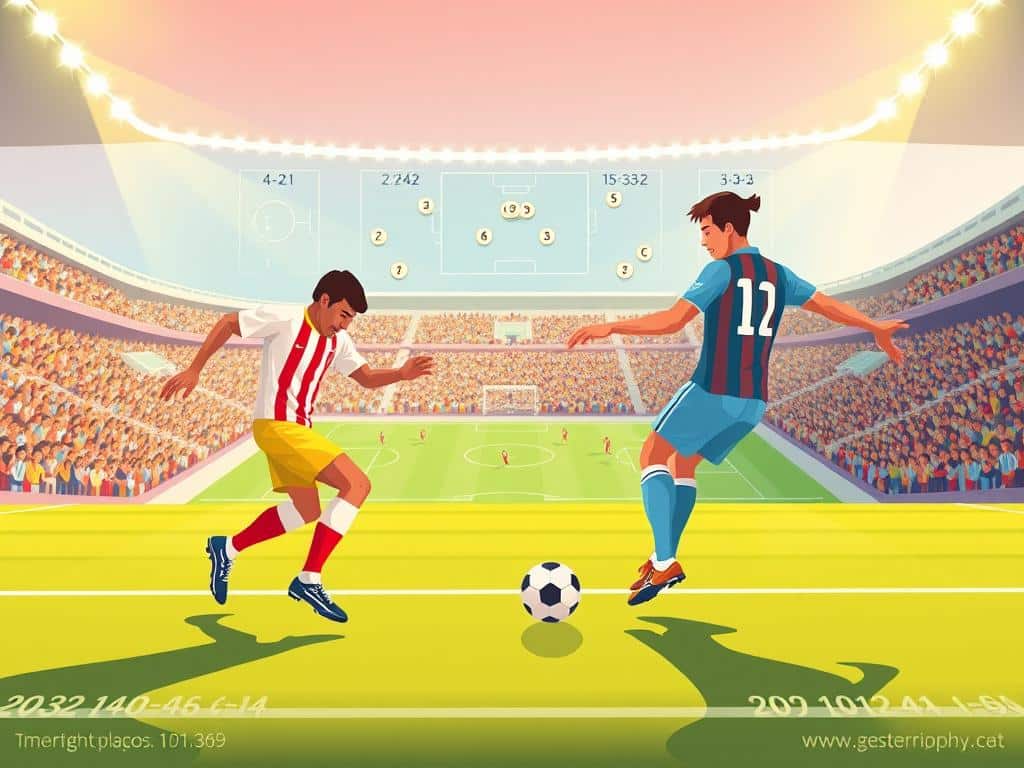For 16 straight years, one football powerhouse dominated matches by keeping the ball an astonishing 70% of the time. That streak finally ended in 2024, marking a new chapter for the legendary squad.
This team rewrote history with their signature short-passing style, winning three major tournaments between 2008-2012. Fans worldwide debated whether their approach was boring possession or pure artistry.
Now, under new leadership, the squad is evolving. Their recent loss to Croatia (with just 53% possession) hints at exciting tactical changes while honoring their glorious past.
What made their golden era so special? How did midfield maestros like Xavi and Iniesta perfect this beautiful style? Let’s explore the magic behind one of football’s most influential playbooks.
The Origins of Spain’s Tiki-Taka Revolution
The shift from physical play to possession dominance didn’t happen overnight—it took a visionary coach and a golden generation. Before 2006, Spanish football was synonymous with “La Furia Roja,” a bullfighting-inspired style relying on speed and crosses. But a new philosophy was brewing, one that prioritized control over chaos.

From La Furia Roja to Possession Pioneers
Luis Aragonés, the fiery coach, made a bold call in 2006: “We play OUR way.” He built around Xavi and Iniesta, midfield maestros who treated the ball like a chess piece. Marcos Senna, the unsung anchor, shielded the defense, letting creators thrive.
Luis Aragonés and the 2008 Euro Blueprint
Euro 2008 became the proving ground. Spain’s 1-0 wins weren’t flashy—they were surgical. David Villa’s goals and a record 75% possession rate stunned opponents. Aragonés’ 4-1-4-1 formation was the secret sauce, blending defensive grit with artistic passing.
Barcelona’s Influence: La Masia and Pep Guardiola
Seven starters in the 2010 World Cup final came from Barcelona’s La Masia academy. Their “pass-first” DNA, honed under Pep Guardiola, became Spain’s backbone. When Guardiola’s Barça dominated clubs, the national team mirrored it on the global stage—a rare club-country synergy.
This evolution of soccer tactics didn’t just win trophies. It redefined how fans saw the beautiful game.
How the Spain National Soccer Team Tiki Taka Works
Six midfielders, zero strikers—sounds crazy, but it rewrote soccer’s rulebook. This wasn’t just about keeping the ball; it was about sculpting the game with geometric precision. Under manager Vicente del Bosque, the squad averaged 68% possession, turning matches into chess matches.
Short Passing and the Art of Possession
Short passing wasn’t a tactic—it was a religion. Players moved in triangles, creating angles that exhausted opponents. Xavi, the maestro, completed 91% of his passes in the 2010 World Cup. The mantra? “Take the ball, pass the ball.”

The False Nine and 4-6-0 Formation
Euro 2012 stunned fans with a strikerless 4-6-0 formation. Cesc Fàbregas played as the false nine, dropping deep to confuse defenders. Six midfielders meant relentless control, weaving through defenses like a needle through thread.
Key Players: Xavi, Iniesta, and Busquets
Sergio Busquets was the silent engine—intercepting threats before they materialized. Andres Iniesta’s 2010 World Cup winner epitomized Tiki-Taka’s beauty. Together, they turned a tournament into a masterclass.
Dominance on the Global Stage: 2008-2012
Three tournaments, three trophies—Spain’s golden era wasn’t just about winning; it was about rewriting the rules. With possession as their weapon, they turned matches into masterclasses, leaving opponents chasing shadows.
Euro 2008: The First Triumph
Fernando Torres’ 33rd-minute strike in the final against Germany wasn’t just a goal—it was a declaration. Under Luis Aragonés, the squad played with a swagger, averaging 75% possession. Critics called it cautious, but 1-0 wins masked their ruthless efficiency.
2010 World Cup: Control Over Chaos
Seven games, seven goals—all 1-0 wins. The 2010 World Cup showcased Del Bosque’s genius. Xavi and Iniesta dictated play, while Sergio Busquets shielded the backline. Opponents barely touched the ball, let alone threatened Iker Casillas’ goal.
Euro 2012: The False Nine Masterclass
No strikers? No problem. Del Bosque’s bold 4-6-0 formation in the Euro 2012 final stunned Italy. Cesc Fàbregas, the false nine, dropped deep, creating space for Silva and Alba to exploit. A 4-0 thrashing with just 59% possession proved efficiency trumped excess.
Even in 2022, echoes remained—77% possession against Morocco—but the magic had evolved. The golden era’s lesson? Control isn’t just keeping the ball; it’s knowing when to strike.
The Legacy and Future of Spain’s Tiki-Taka
Football’s chess masters aren’t done innovating yet. While the golden years of 70% possession are fading, the style play thrives in new ways. Coaches like De la Fuente now blend vertical wingers (hello, Lamine Yamal!) with the old control.
Modern stars like Pedri prove short passes still rule—just faster. Guardiola’s Manchester City even mixed it with Haaland’s power. But recent years show a paradox: 68% possession can’t always win games.
Opponents like Germany and Japan now out-pass the pioneers. Yet, the approach isn’t dead—it’s evolving. Think of it as Tiki-Taka 2.0: fewer sideways passes, more punch.
So, is the game’s most artistic success story over? Hardly. It’s just learning new moves.







